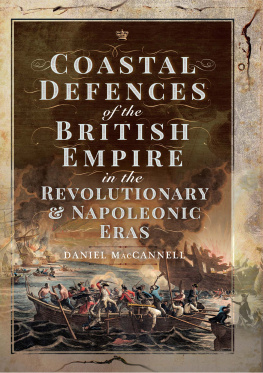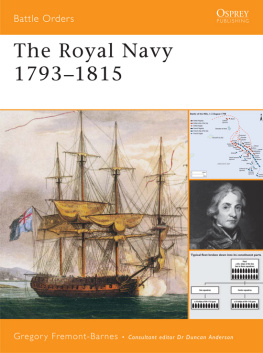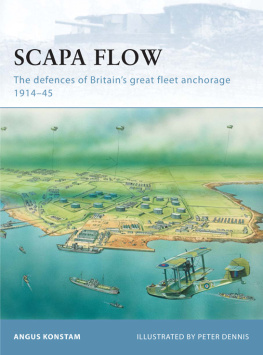Pagebreaks of the print version

C OASTAL D EFENCES
of the
B RITISH E MPIRE
in the Revolutionary & Napoleonic Eras
For Staff Cdr David John Hayes RN (19502015)
C OASTAL D EFENCES
of the
B RITISH E MPIRE
in the Revolutionary & Napoleonic Eras
DANIEL M AC CANNELL
First published in Great Britain in 2021 by
Pen & Sword Military
An imprint of
Pen & Sword Books Ltd
Yorkshire - Philadelphia
Copyright Daniel MacCannell, 2021
ISBN 978 1 52675 345 8
eISBN 978 1 52675 346 5
Mobi ISBN 978 1 52675 347 2
The right of Daniel MacCannell to be identified as the Author of this work has been asserted by him in accordance with the Copyright, Designs and Patents Act 1988.
A CIP catalogue record for this book is available from the British Library.
All rights reserved. No part of this book may be reproduced or transmitted in any form or by any means, electronic or mechanical including photocopying, recording or by any information storage and retrieval system, without permission from the Publisher in writing.
Pen & Sword Books Ltd incorporates the Imprints of Pen & Sword Archaeology, Atlas, Aviation, Battleground, Discovery, Family History, History, Maritime, Military, Naval, Politics, Railways, Select, Transport, True Crime, Fiction, Frontline Books, Leo Cooper, Praetorian Press, Seaforth Publishing, Wharncliffe and White Owl.
For a complete list of Pen & Sword titles please contact
PEN & SWORD BOOKS LIMITED
47 Church Street, Barnsley, South Yorkshire, S70 2AS, England
E-mail:
Website: www.pen-and-sword.co.uk
or
PEN AND SWORD BOOKS
1950 Lawrence Rd, Havertown, PA 19083, USA
E-mail:
Website: www.penandswordbooks.com
F OREWORD
The current populations of France and the United Kingdom are effectively identical in size. It is therefore usually forgotten that the former was, in the late eighteenth century, a demographic juggernaut. By the time Lord Cornwallis and Joseph Bonaparte concluded the short-lived Peace of Amiens in March 1802, France had more than three times the population of the UK, then including the twenty-six counties of southern Ireland. Moreover, Irelands population today is only around 40 per cent higher than it was at that time, while Englands has shot up sevenfold. Thus, as of 179698, when the French army and navy made multiple descents on the Emerald Isle aimed at fomenting revolution there, the English in England outnumbered the Irish in Ireland by as little as 3:2. Metropolitan France also boasted nearly half the population of the entire British Empire, India included. One curious effect of this was that, during the wars covered by this book, around one in eight adult males was serving in uniform in traditionally anti-militarist Britain, a proportion three times higher than in militarist France. The population imbalance also helps to explain Napoleon Bonapartes belief that England was merely a small island not unlike Corsica or Elba which naturally belonged to France.
The island nation concept was itself fairly new, however. When Edward VI, Englands first unambiguously Protestant king, came to the throne in 1547, he inherited three land borders that had been in place for centuries. One separated the English colony in Ireland known as the Pale, roughly the modern counties of Louth, Meath, Dublin and Kildare, from the Irishry, who had their own aristocracy, language, and laws, and independent diplomatic and commercial relations, notably with Spain. A second border lay between the north of England and Scotland: the latter being, in some key respects, a French puppet state. And a third divided the twenty-square-mile English territory of Calais containing the third-largest town in the kingdom, after Norwich and ahead of Bristol from France itself. King Edward also ruled the city of Boulogne, captured from the French by his father in 1544. Just sixty years later, all this had changed beyond recognition: with Boulogne returned in 1550, Calais lost to a gargantuan French army in 1558, Scotland captured by home-grown pro-English Protestants in 1560, and the Irishry subjected to a brutally effective conquest, culminating in the Flight of the Earls to Spanish Flanders in 1607. Only then, for the first time, did the political entity ruled from London have no land borders to defend; and only then did the funding of a standing navy emerge as a major political football. As we shall see, the unaccustomed receipt of wholly adequate funding by the Royal Navy and Woolwich Arsenal during the decade of peace from 1783 to 1792, along with a welter of improvements in military and civil administration, would profoundly affect the course of the subsequent two decades of war.
The period covered by this book may at first seem odd, given that excellent ones on similar topics have tended to cover much longer periods (e.g. Norman Longmates Island Fortress ) or much shorter ones (e.g. Richard Glovers Britain at Bay ). My choice is rooted in contemporaries lived experience. Numerous Britons who served as junior officers of the Ordnance, Army, and Royal Navy during the American War of Independence notably including William Twiss, John Moore, and Horatio Nelson had become senior ones by the start of the Napoleonic War. Joining the army in the ranks was usually for life; generals and admirals routinely served past the age of 70 if they were lucky enough to survive that long; and the service lives of ships, guns, and even earthworks could be measured in decades rather than years. Technological departures, even the famed Martello towers that will form such an important part of my narrative, tended to be incremental rather than revolutionary. Probably, the radical new clothing fashions of the first decade of the nineteenth century have produced an illusion of more major or rapid societal change than there actually was, at least on this side of the Channel.
Likewise, with regard to this books geographic scope, I implicitly share William Pitt the Elders view that the defence of the British Isles could not be conducted in isolation and that the defence of the homeland must form part of a worldwide strategy. For that reason, I have not shied away from detailed discussions of the lessons that British subjects learned from their efforts to defend, or indeed attack, coastal positions in any part of the world. In the process of researching this book, I also stumbled upon a surprisingly dense web of Swedish influences on the theories and practices of inshore naval combat that were adopted by both France and Britain.
Those peddling the notion of Britain standing alone against Nazism are often rightly upbraided for forgetting or ignoring that the Britain of 1940 was merely the tip of a quasi-democratic Anglophone iceberg. But when the Peace of Amiens shattered in 1803, that berg had barely begun to coalesce. The Australian penal colony was still in its infancy; India, run by an unaccountable for-profit company; New Zealand, seen but not heard. South Africa had been taken from the Dutch just eight years before, and since returned to them. English Canada was filling up rapidly with economic refugees, many steeped in republican ideology, from an impoverished and broadly hostile United States. Sending the king to Ottawa and the fleet to Halifax and carrying on the war from there if things went belly-up in Europe was not yet a credible option. Worse, having formed an alliance with Austria against Prussia in the 1740s and with Prussia against Austria in the 1750s and 1760s, then fought against France, Spain and Holland simultaneously as recently as the 1780s, and attacked DenmarkNorway in 1801, Britain had no consistent allies in its own neighbourhood apart from Portugal, which was relatively insignificant economically and, for the time being, militarily.















